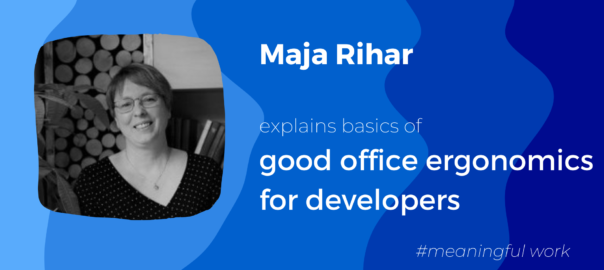In Meaningful work interviews I talk to people about their area of work and expertise to better understand what they do and why it matters to them.
Maja Rihar (LinkedIn) is an ergonomics consultant specializing in a workplace environment. In our conversation, I tried to learn current best practices in how to set up my work environment.
What do you do?
I teach people how to best use ergonomic accessories for office use. I have past experience with managing offices and I was also in charge of ensuring workplace safety. While the popular belief is that it’s not dangerous to work in an office my experience and statistics disagree with this. That’s why I’ve started helping people to adjust workspaces to each individual worker.
Why are office workers getting hurt in the long run?
What I’ve noticed is that corporate training on workplace safety of employees is not effective. There’s also an issue that our population is getting taller on average – about 12 cm in the last 100 years. Our national office equipment standards do not adjust fast enough to these population changes.
Our current standards are made for people that are on average 178 cm in height. If you’re over 180 cm in height you’ll have problems with working in your current office environment. Lots of tall people are telling me about their back problems.
Any tips on what common mistakes you see among IT workers in their offices?
One very common mistake I see is that people have their keyboards too far from their bodies. It should be about 20 cm from the body. During a workshop, we’ll measure this distance and make sure that you have a visual feeling for where it should be.
I also suggest that you set an alarm for every 15 minutes that reminds you to stand up and sit down with a correct posture. Once you sit down with a correct posture you’ll once again be able to sit correctly for a while. Anything longer than about 15 minutes makes the body slouch so 15 minutes is a good time interval to move your body. Just doing this would prevent a lot of long-term damage to the musculoskeletal system.
Laptops shouldn’t be used for any long-term work. They are ergonomically correctly set up only when used with an external keyboard with a screen on a raised platform. The constant hunched-down position is very hard on the body. This is further compounded by all the mobile and other device use.
I’m happy to see more and more standing desks in offices. I think this is one of the best things that you can do for your body. Mainly because it forces you throughout the day to keep moving all the time as you switch from standing to sitting setup and back.
How do you pick good equipment?
I think it’s important that you trial many different vendors and that you are picky with what you choose. Don’t just try one office chair. Try many, figure out if you’ll know how to adjust it correctly, and also ask your peers what worked for them.
When setting up a home office environment you can learn from your work office. If you ever try to work from your kitchen table you’ll quickly get a feeling if it’s a better or worse experience than your office table. This can help you guide your decisions and you’ll know how to improve it toward what feels good.
It’s also a good idea to talk to experts before making these choices. Any office equipment that you’ll buy will probably be used for many hours every day for the next ten years. Getting good advice upfront can be a good investment in such a context.
Any more practical advice?
You should think about how you work. Make sure to adjust your body and how you work so that it will support you in a long run.
Invest in quality lighting. Get into the habit that you’re opening windows and adding fresh air to your space.
Take breaks often and move your body during these breaks. I don’t think it’s healthy to work for long periods and then go train for another long period. It’s much better to mix both throughout the day.
Talk to your peers about how they’re solving their problems. Seeing how others adjust their workspace makes it much easier for you to imagine how you could improve yours. The more embodied your experience with trying different accessories is the easier it will be to get a feel if it’s right for you.
Can you recommend any additional resources on this topic?
Official guidance
- EU guidelines on this topic – (E-fact 13 documents about how an office should be arranged)
- Slovenian official OSHA site
Vendors
Good YouTube Channels on this topic:
What I learned from talking with Maja
The embodied experience of trying different ergonomic accessories is worth the effort.
Using external triggers to make sure that I check on my pose.
Standing desk provides a lot more benefits than I expected and the hype seems justified.
